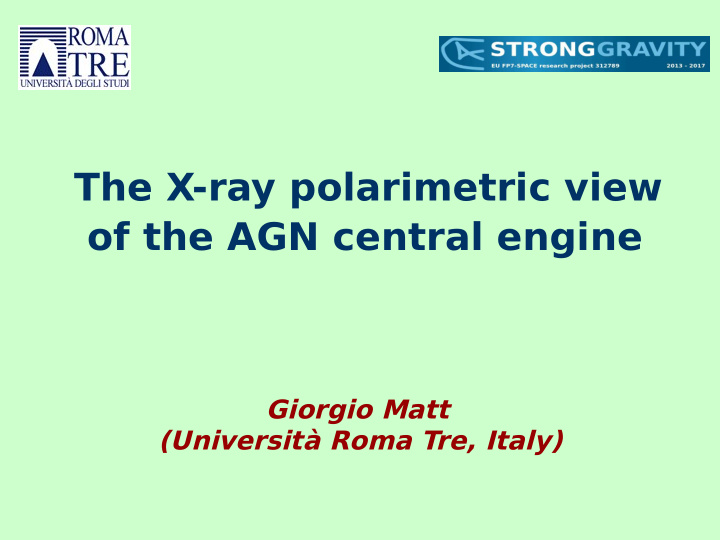



The X-ray polarimetric view of the AGN central engine Giorgio Matt (Università Roma Tre, Italy)
Plan of the talk Plan of the talk The geometry of the hot X-ray corona Strong gravity and the BH spin The orientation of the torus The GC as a low luminosity AGN Observational perspectives
Active Galactic Nuclei in X-rays Active Galactic Nuclei in X-rays In AGN the primary X-ray emission is due to Inverse Compton by electrons in a hot corona of the UV/soft X-ray disc photons. It is likely to be signifjcantly polarized (e.g. Haardt & Matt 1993, Poutanen & Vilhu 1993). Part of the primary emission illuminates the disc and is refmected (and polarized) via Compton Scattering
The geometry of the hot corona The geometry of the hot corona The geometry of the hot corona is unknown. Emission is expected to be polarized if the corona OR the radiation fjeld are not spherical Slab and sphere geometries, temperature and τ as per IC4229A (Brenneman et al. 2014) Tamborra et al., in prep.
The geometry of the hot corona The geometry of the hot corona The geometry of the hot corona is unknown. Emission is expected to be polarized if the corona OR the radiation fjeld are not spherical Slab geometry, temperature as per IC4229A, difgerent Tamborra et al., in prep. values of tau
Probing strong gravity efgects Probing strong gravity efgects General and Special Relativity efgects around a compact object (“strong gravity efgects”) signifjcantly modifjes the polarization properties of the radiation. In particular, the Polarization Angle (PA) as seen at infjnity is rotated due to aberration (SR) and light bending (GR) efgects (e.g. Connors & Stark 1977; Pineault 1977). The rotation is larger for smaller radii and higher inclination angles (Connors, Stark & Piran 1980) Orbiting spot with: a=0.998; R=11.1 Rg i=75.5 deg Newtonian Newtonian (Phase=0 when the spot - - - - - - - - - - - - - - - - - - - - - - - - - - - - - - - - - - - - is behind the BH). The PA of the net (i.e. phase-averaged) radiation is also rotated!
Polarization of refmected fmux Polarization of refmected fmux Polarization of refmected (continuum) radiation is large, up to 20% (Matt et al. 1989) assuming isotropic illumination, a plane-parallel refmecting slab and unpolarized illuminating radiation. The exact values depend on the actual geometry of the system and on the polarization degree of the primary radiation.
Refmection in Relativistic discs Refmection in Relativistic discs E E Breaking of the symmetry due to SR (Doppler boosting) also causes a rotation of the PA with respect to the Newtonian case. Changes in the illumination properties (e.g. in the height of the lamp-post) will cause changes in the total PA, which is therefore likely to be time- (and fmux-) dependent. Variations of the height have been claimed in several AGN (e.g. Miniutti et al. 2003, Parker et al. 2014).
Refmection in Relativistic discs Refmection in Relativistic discs Variation of h with time implies a time and fmux variation of the degree and angle of polarization. The efgect depends also on the BH spin. Dovciak et al. (2011)
Refmection or absorption? Refmection or absorption? Polarimety can distinguish The relativistic between the two models! refmection interpretation of the broad feature often seen in Seyfert galaxies has been challenged: complex absorption? Marin et al. (2012)
The orientation of the torus The orientation of the torus Geometry of the Geometry of the torus: torus: the polarization angle will give us the orientation of the torus, to be compared with IR results, and with the ionization cones (Goosmann & Matt 2011) Raban et al. (2009)
The orientation of the torus The orientation of the torus Goosmann & Matt (2011)
GC as a low luminosity AGN GC as a low luminosity AGN Cold molecular clouds around Sgr A* (i.e. the supermassive black hole at the centre of our own Galaxy) show a neutral iron line and a Compton bump → Refmection from an external source!?! No bright enough sources are in the surroundings. Are they refmecting X-rays from Sgr A*? so, was it one million times brighter a few hundreds years ago? Polarimetry can tell! (Churazov et al. 2002)
GC as a low luminosity AGN GC as a low luminosity AGN Polarization by scattering from Sgr B complex, Sgr C complex The angle of polarization pinpoints the source of X-rays The degree of polarization measures the scattering angle and determines the true distance of the clouds from Sgr A*. Marin et al. 2014
Observational perspectives Observational perspectives The illustrated cases can be addressed by small/medium- size X-ray polarimetric missions. XIPE (X-ray Imaging Polarimetry Explorer). Selected by ESA (M4) for phase A study. Final selection: May 2017 IXPE (Imaging X-ray Polarimetry Explorer). Selected by NASA (SMEX) for phase A study. Final selection: Early 2017 PRAXyS (Polarimeter for Relativistic Astrophysical X-ray sources). Selected by NASA (SMEX) for phase A study. Final selection: Early 2017
Observational perspectives Observational perspectives Example: MDP=2% in 2-8 keV with XIPE Source Type Texp (ks) IC 4329A Sy1 230 GRS1734-292 Sy1 400 MCG+8-11-11 Sy1 410 NGC 2110 Sy2 220 MCG+5-23-16 Sy2 260 NGC 5506 Sy2 550 Total ~2000
Summary Summary X-rays probes the central engine of AGN Spectroscopy probes dynamics Timing probes scales Polarimetry probes geometry
Recommend
More recommend